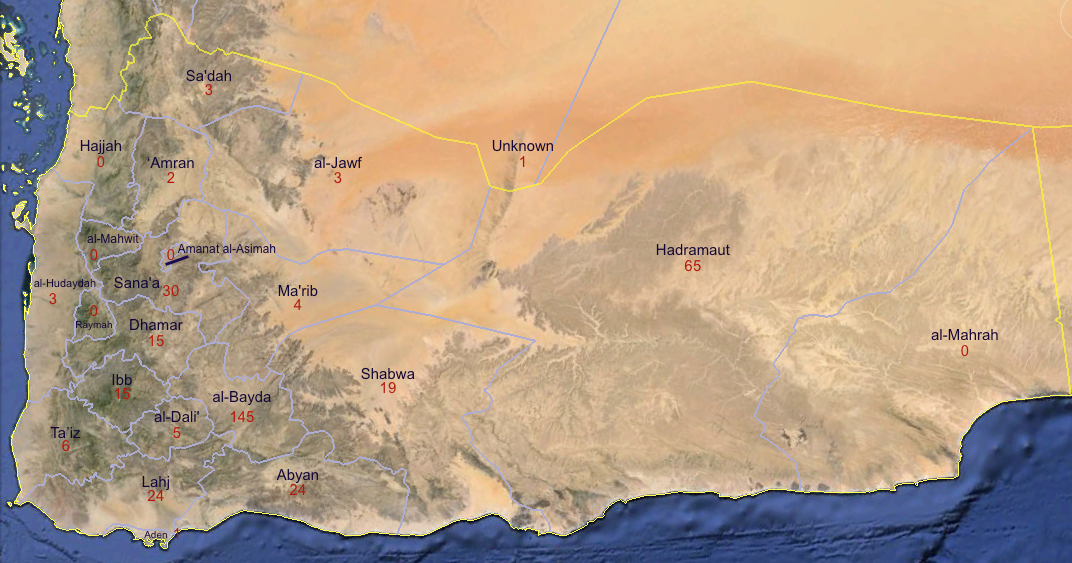As with all guest posts, the opinions expressed below are those of the guest author and they do not necessarily represent the views of this websites administrator and does not at all represent his employer at the Washington Institute for Near East Policy.
Jihadology aims to not only provide primary sources for researchers and occasional analysis of them, but also to allow other young and upcoming students as well as established academics or policy researchers to contribute original analysis on issues related to jihadism. If you would like to contribute a piece, please email your idea/post to azelin [at] jihadology [dot] net.
Click here to see an archive of all guest posts.
—
Making sense of alleged AQAP-Houthi cooperation: local pragmatism or further accommodation between al-Qaeda and Iran?
By Andrew Zammit
The latest report by the United Nations Analytical Support and Monitoring Team reiterated allegations that al-Qaeda in the Arabian Peninsula (AQAP) is cooperating with the Iran-backed Houthi rebels in Yemen. Is this alleged cooperation likely to have resulted from the local dynamics of the Yemeni conflict, or does it reflect a broader accommodation between al-Qaeda and Iran?
Recent United Nations reports have contended that Yemen’s Houthi rebels and al-Qaeda in the Arabian Peninsula (AQAP) have been cooperating in ways that each would prefer hidden. On 6 February 2025, the Analytical Support and Monitoring Team stated that AQAP had a “pragmatic agreement with the Houthis that had lasted for the past three years, which was described as opportunistic and transactional” and that the “agreement included mutual non-aggression, prisoner exchanges and the movement of weapons.”
Similarly, on 11 October 2024 the United Nations Panel of Experts of Yemen reported concerns about an “opportunistic alliance” between the Houthi rebels and AQAP, “characterized by cooperation in security and intelligence, offering safe havens for each other’s members, reinforcing their respective strongholds and coordinating efforts to target the Government’s forces”. The Panel also reported an agreement “that the Houthis would transfer four uncrewed aerial vehicles, as well as thermal rockets and explosive devices, and that the Houthis would provide training to AQAP fighters” and that “they discussed potential support by AQAP in attacks against maritime targets”.
Claims of AQAP-Houthi cooperation are not new, but these recent reports add detail to the persistent allegations. Such claims have not been accompanied by any apparent rhetorical rapprochement between the two movements; AQAP issued a statement denouncing the Houthis as recently as late January.
How then should we make sense of these allegations, given decades of hostility between Salafi-jihadist movements like al-Qaeda and Shia Islamist militants like the Houthis?
One possibility, assuming the reports are broadly accurate, is that this cooperation reflects local dynamics in Yemen and the peculiarities of AQAP rather than having broader significance. Several scholars have long argued that AQAP is not monolithic. Elisabeth Kendall noted in 2021 that defining “who or what constitutes AQAP is more challenging today than it was a decade ago. As Yemen’s internationalized civil war has fragmented, different AQAP splinters have emerged, some of them no more than mercenary gangs.”
This raises the possibility that the reports are referring to pragmatic cooperation with the Houthis by one or more factions under the AQAP banner, which has happened before. For the other side of the equation, Eleonora Ardemagni notes the benefits the Houthis would gain from such cooperation. Scholarship on civil wars has often emphasised instrumental motivations and that outwardly opposed groups may cooperate in various ways.
This is broadly consistent with reports of Houthi cooperation with al-Qaeda’s affiliate in neighbouring Somalia, al-Shabaab, noted by another United Nations expert panel. Experts have likewise argued that this may reflect local dynamics and pragmatic purposes, with Christopher Anzalone stating that, “the more likely scenario is a transactional relationship between individuals or smuggling/criminal networks affiliated with both groups, rather than a direct, close alliance or collaboration. This could be driven by profit or an ‘enemy of my enemy is my friend’ type of strategic calculation.”
However, another possibility is that the reported AQAP-Houthi cooperation represents something larger, that speaks to current controversies among Salafi-jihadist ideologues over al-Qaeda’s relationship with Iran. This is the possibility that al-Qaeda, under its post-Zawahiri leadership, is increasingly accommodating Iran and it’s “axis of resistance”.
This may initially appear unlikely, as there are expansive religious and ideological differences between the Shia Islamist worldview avowed by the Islamic Republic of Iran and the Salafi-jihadist worldview avowed by al-Qaeda.
They also have dramatically different strategic interests, given that Iran’s “axis of resistance” – its network of partners (not necessarily proxies) across the Middle East, including Hamas in Palestine, Hezbollah in Lebanon, the Houthis in Yemen, and many militias in Syria and Iraq – has traditionally stood in the way of al-Qaeda spreading its influence. This was most evident with Iran and al-Qaeda being on opposite sides in the Syrian civil war, with Iran supporting the Assad regime and al-Qaeda seeking (unsuccessfully) to entrench itself in the Sunni-majority insurgency.
At the same time, there has also been decades’ worth of evidence of al-Qaeda’s cooperation with Iran, alongside periods of conflict.
Al-Qaeda’s pragmatic cooperation with Iran had always been controversial in the Salafi-jihadist movement. It was often kept secret, with bin Laden and Zawahiri publicly denouncing Iran while secretly seeking to negotiate an agreement that has been likened to a non-aggression pact. One of the accusations Islamic State’s precursor made shortly after breaking away from al-Qaeda’s leadership was that they had been forbidden from directly attacking Iran, with Abu Muhammad al Adnani bitterly stating “that Iran owes al Qaeda invaluably”.
The controversy over cooperation with Iran came to the fore after al-Qaeda’s leader Ayman al-Zawahiri was killed by a US air strike in Kabul on 31 July 2022. In the aftermath, al-Qaeda was widely reported to have chosen Saif al-Adel as their new leader, an Egyptian al-Qaeda commander with a decades-long terrorist track record. He had been released from an Iranian prison in 2015 but has since been unable to leave the country.
Al-Qaeda has never publicly announced al-Adel’s leadership, presumably out a desire to avoid causing dilemmas for their Taliban hosts, but potentially also because of embarrassment over their leader being based in Iran.
For example, Hay’at Tahrir al-Sham (which evolved from Al-Qaeda’s former Syrian affiliate Jabhat al-Nusra) had ridiculed the idea of al-Qaeda choosing a leader based in Iran. The highly influential Jordanian Salafi-jihadist scholar Abu Muhammad al-Maqdisi had also criticised the prospect of al-Qaeda choosing an Iran-based leader like al-Adel, stating that it was “impossible for them to choose a leader in Iran or under the authority of any government.”
Intra-jihadist controversies over al-Qaeda’s relationship with Iran escalated under al-Adel’s presumed leadership, often due to al-Qaeda’s expressions of unrestrained support for Hamas after 7 October 2023.
Salafi-Jihadist movements like al-Qaeda have traditionally been highly critical of Hamas, for being affiliated with the Muslim Brotherhood, participating in elections, engaging in ceasefires, being nationalist rather than seeking a global caliphate, not enforcing strict sharia law in the territory it controls, cooperating with non-Muslim fighters, and for partnering with Iran and Syria.
However, in recent years al-Qaeda’s attitude towards Hamas has become far more positive, particularly after the massacres of 7 October 2023. In December 2023, an al-Qaeda video described “the blessed al-Aqsa Flood operation” as “the second September 11”, showing that al-Qaeda had shifted from denouncing Hamas for impurities and deviations to likening Hamas’s war against Israel to its own war against the West.
Similarly, Al-Qaeda’s 21 April 2024 eulogy for Hamas leader Ismail Haniyeh was effusive in its praise, prompting a backlash from Salafi-jihadist ideologues including al-Maqdisi. By praising a political leader, rather than merely praising members of Hamas’s military wing who attacked Israel, the eulogy “fuelled more speculations about ‘the new’ al-Qaeda leadership, suspected of being based in Iran, and whether it has turned.”
Al-Qaeda’s unabashed praise for Hamas has been perceived as crossing the line from mere pragmatic cooperation with Iran to ideological overtures to an “axis of resistance” member. Al-Maqdisi stated that al-Qaeda’s new leadership was far less critical of Hamas than either Amyan al-Zawahiri or Osama bin Laden had been. He noted Hamas’s ties to Iran and likened praising Hamas to praising Shia Islamist movements like Hezbollah and the Houthis. Canadian Islamist Tariq Abd al-Halim was more direct than al-Maqdisi, arguing that al-Qaeda had indeed deviated, partly attributing this to the influence of al-Adel’s father in law, the Egyptian jihadist Abu al-Walid al-Masri who had once been described as a “longtime al-Qa`ida-Iran middleman”.
Given that Hamas is a Sunni Islamist movement at war with Israel, it is unclear whether many Salafi-jihadists would necessarily view praise for Hamas as undermining al-Qaeda’s positioning of itself as the protector of Sunni Muslims, despite Hamas’s support from Iran. Some had entered the fray




